PLM IT systems
PLM processes
PLM solution
PLM projects and adoptive change management
Summary
Examination of PLM (Product Lifecycle Management)
In this paper we examine the general scope of PLM. As there is no general agreed definition of the term PLM, this paper defines our perception of what is within the scope of PLM. The different parts of the scope and the functionalities of the PLM IT systems are furthermore presented.As PLM is a relatively new concept in the academic environment the sources used in this chapter is represented as both theory and practice from consultants; [Ameri and Dutta, 2005], [Stark, 2005], [CIMdata et al., 2005], [CIMdata, 2003b], [CIMdata, 2001] [CIMdata, 2003a], [Grieves, 2006] and [IBM, 2006].
 Figure 1: The dual lifecycle model.
Figure 1: The dual lifecycle model.Product Lifecycle Management (PLM) deals, as the name implies, with the entire lifecycle of a product. A lifecycle may be divided into many different phases depending on the level of detail. We have in this project developed the model in fig. 1. The model could have been much more detailed but the high level model is sufficient for our needs in the project. The PLM mindset is focused on the product in the entire lifecycle, which means that the view is different from the traditionally division in functionalities and silos in a company. The PLM view follows the product from the first concept to disposal and recycling. The traditional horizontal view is therefore said to be changed to a vertical view. We define a full PLM solution to be when information relating to the products flow across the enterprise and people collaborate around it.
Background and progression for PLM
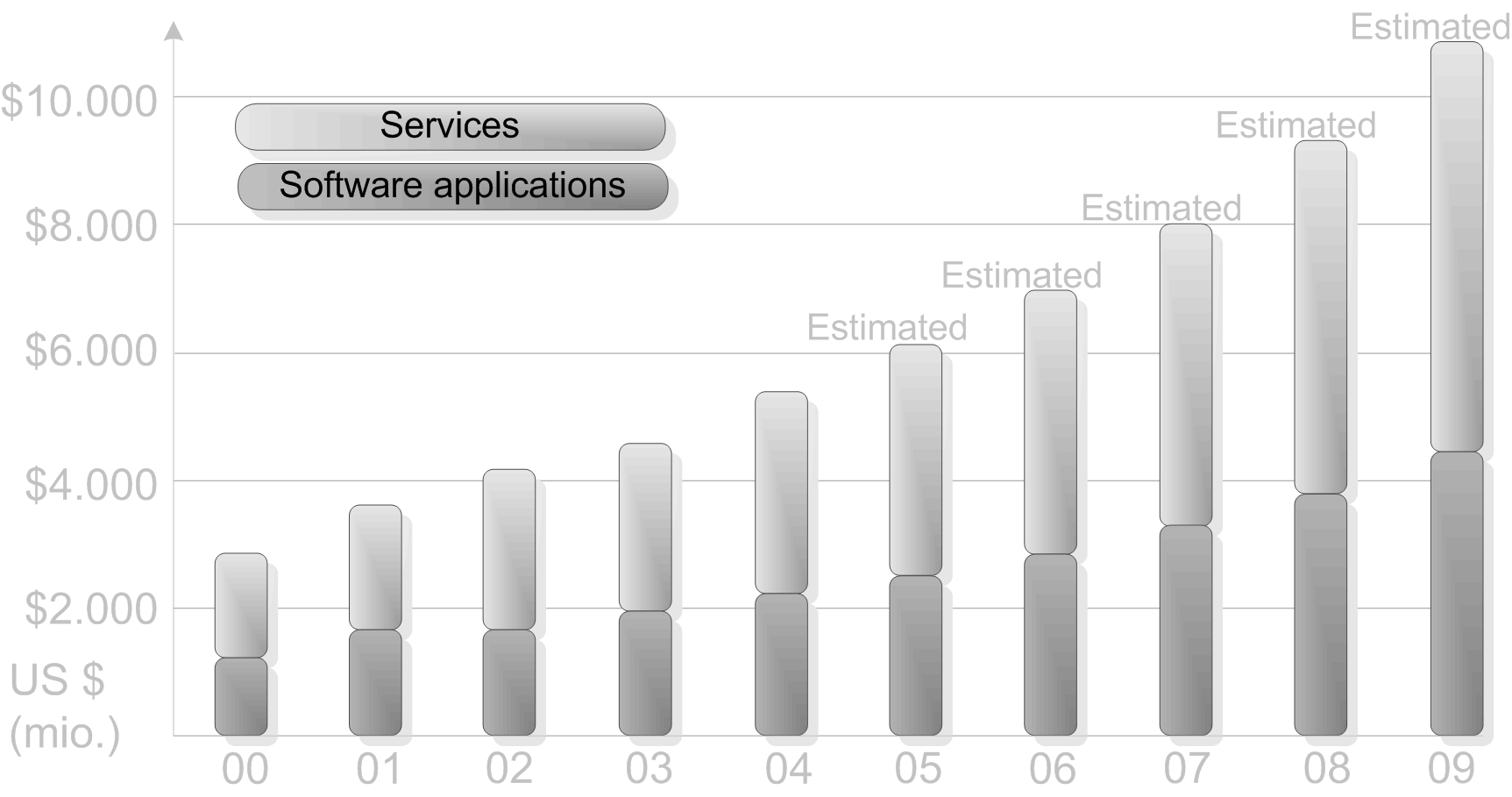 Figure 2: The turnover in the PLM industry the latest 5 years and as expected for the future 5 years. Courtesy of CIMdata
Figure 2: The turnover in the PLM industry the latest 5 years and as expected for the future 5 years. Courtesy of CIMdataPLM is a system which is gaining ground worldwide, due to some of the global business issues it attends to. The turnover for the PLM industry is between U.S. $ 5 and 6 billions in year 2004 [CIMdata et al., 2005] as seen in fig. 2. Although some of the PLM functionalities were originally developed for the CAD environment in the mid-80's the scope of the broad PLM systems is still in a young market especially outside USA and even more so in Denmark. The driving forces in development of the PLM systems have mainly been the aerospace, military and automotive industries due to the complexity and large number of parts in the products in these industries. PLM is expanding its scope and will continue to develop in the direction governed by the demand in the market and by the development of new technologies.
Some of the business issues which are related to PLM are: increase in product complexity, management of large amounts of data, globalization, environmental awareness, product traceability, and importance of speed in business processes. This is elaborated in the rest of the paper.
o Enabling IT systems
o Business processes
o Organization
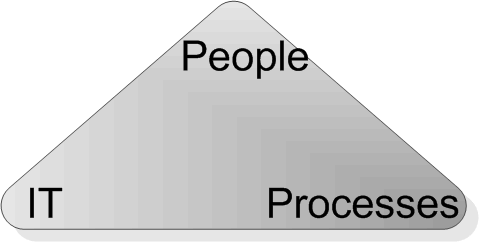
PLM IT systems
In this section a description of functionalities in the scope of PLM systems, which can be supported by means of IT functionalities, is presented. In this section the sources for the article are complemented with source [Crnkovic and Asklund, 2003]
The scope of a large part of PLM is called PDM (Product Data Management) dates back to the management of data in the CAD environments, when the amount of data grew rapidly. The main focus with this part of PLM is to manage the data (in the terminology we use, this functionality is said to mainly manage information residing in documents). The automatic management of documents is done from the creation of the document, through changes with different versions and until obsolescence. The functionalities related to this, thereby relives the earlier mentioned issues with the amount of data, the complexity and traceability.
Core functionalities for management of documents in the enterprise:
o Document vault and document management
o Access based on user groups
o Product structure management
o Workflow and process management
o Classification management
In short, the purpose with these functions can be said to be the right information, to the right people, at the right time. By right information we mean clear, concise and valid information.
The full scope of PLM does not only provide functionality for controlling product related information across the entire lifecycle. It also enables collaboration and support global organizational and virtual co-located teams for product development in extended enterprises. This is functionalities which remedies the current globalization in the businesses. The following PLM functionalities is related to these qualities.
Functionalities for co-working in the extended enterprise:
o Project management
o Collaborative tools
o Virtual product handling
Document vault and document management
 Figure 3: The process of checking in and out of the document vault. [IBM, 2002]
Figure 3: The process of checking in and out of the document vault. [IBM, 2002]PLM has a document vault which controls and protects the data, information and knowledge in the documents (files of different kinds and formats). See fig. 3.
Document management handles the documents in and out of the document vault, as well as inside it. When a new document is created, it may be done in the PLM system by means of predefined templates. When an author opens a document to make changes in it, the document is checked out of the system meanwhile, and is locked for other users to prevent conflicts. Other users may only see and read in the meantime. When a document is checked in, the new document is stored as the current document, while the old version is hidden for users. The document vault thereby contains up to date product information. The old version may be retrieved if necessary though.
When a document is checked into the document vault, the author can add a comment about the validity and completeness of the document. Furthermore the can be released and the status of a document can thereby be changed.
The documents in the vault can be stored in one server, in many servers or replicated on different servers. This is a question of system architecture, and it does not matter to the user where the actual document is stored. The user only has to click on the link leaving the complexity of finding the document to the PLM system.
Access based on user groups
 Figure 4: Different users need different information. They need to see different information depending of their functionality. The figure is developed based on [CIMdata, 2001].
Figure 4: Different users need different information. They need to see different information depending of their functionality. The figure is developed based on [CIMdata, 2001].Information is managed automatically by the PLM system in order to share information without creating information overload and to prevent that people thereby spend a lot of time searching for the right information. This means that PLM presents relevant information to the employees and hide unnecessary information, depending on the user group.
Security and access control to the aforementioned document vault are managed by means of user groups, as it is illustrated in fig.6.4. Limited access to documents is based on the need. E.g. suppliers have limited access within the system, hiding sensitive information and preventing information theft.
The user group access to the PLM system is also used to prevent information overload as different groups of employees have different needs. Although employees in different functionalities and thereby, different roles, need information from other functions in the business, they need not all of the information. E.g. employees in the production need to see the MBOM and employees in the development need to see the EBOM. To ensure access to the right information the business must identify the internal customers of the PLM system.
Product structure management
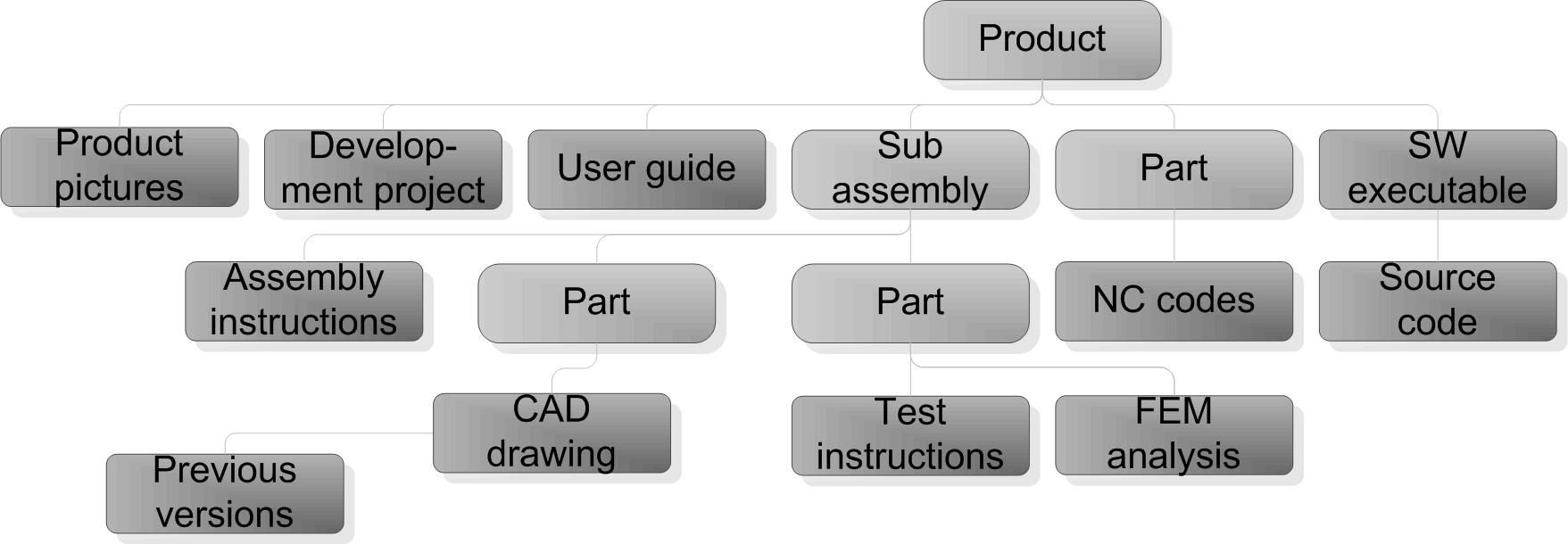 Figure 5: Product structure with links. Here seen with origin in a part of a traditional BOM (light grey boxes) with links to related documents. Based on a figure from [CIMdata et al., 2005].
Figure 5: Product structure with links. Here seen with origin in a part of a traditional BOM (light grey boxes) with links to related documents. Based on a figure from [CIMdata et al., 2005].The documents in the PLM system are structured and managed by links as shown in fig. 5. Relevant documents are linked to e.g. the products or parts. It is not only parts and sub assemblies which are linked to the product. Also the different versions, requirements and other relevant information are linked to the parts and so on. This means that the employees do not need to know which drive or database the documents are saved in. The linking of documents in a structure eases the search for information across functions in the enterprise. And information of where the part, test etc. is used is easily located, thereby making it easier to assess the effects of changes in e.g. a part of a product.
As different user groups can see the product differently, PLM supports different views of product structures. E.g. EBOM and MBOM, which as mentioned earlier, are different documents from the same product structure but used in different contexts.
Workflow management
 Figure 6: IT supported workflow for development of a new document e.g. a new drawing. Workflows can also be used for supporting the workflow in an ECM etc. The figure is based on [CIMdata, 2001].
Figure 6: IT supported workflow for development of a new document e.g. a new drawing. Workflows can also be used for supporting the workflow in an ECM etc. The figure is based on [CIMdata, 2001].As expedient processes is a part of PLM regarding both best practices and enabling in IT systems, one of the functionalities are IT supported processes in workflows. Predefined workflows can transfer information, documents or tasks to employees. In fig. 6 the automated process regarding document management is pictured in a workflow. This workflow could also be for the EC process, the exchange of valid product documentation with suppliers or any other business process. In the approval phase on fig. 6, the documentation of the approval could be by means of an electronic signature, instead of a normal handwritten signature to prevent the cumbersome work with hard copies of documents.
Notification
Notification is a functionality, where an activity in the system can trigger a predefined task. The functionality can inform a user when his approval is needed for an ECM e.g. via the email system. It also allows a user to subscribe to a notification, whenever there is a change to e.g. a component in a product.
Classification management
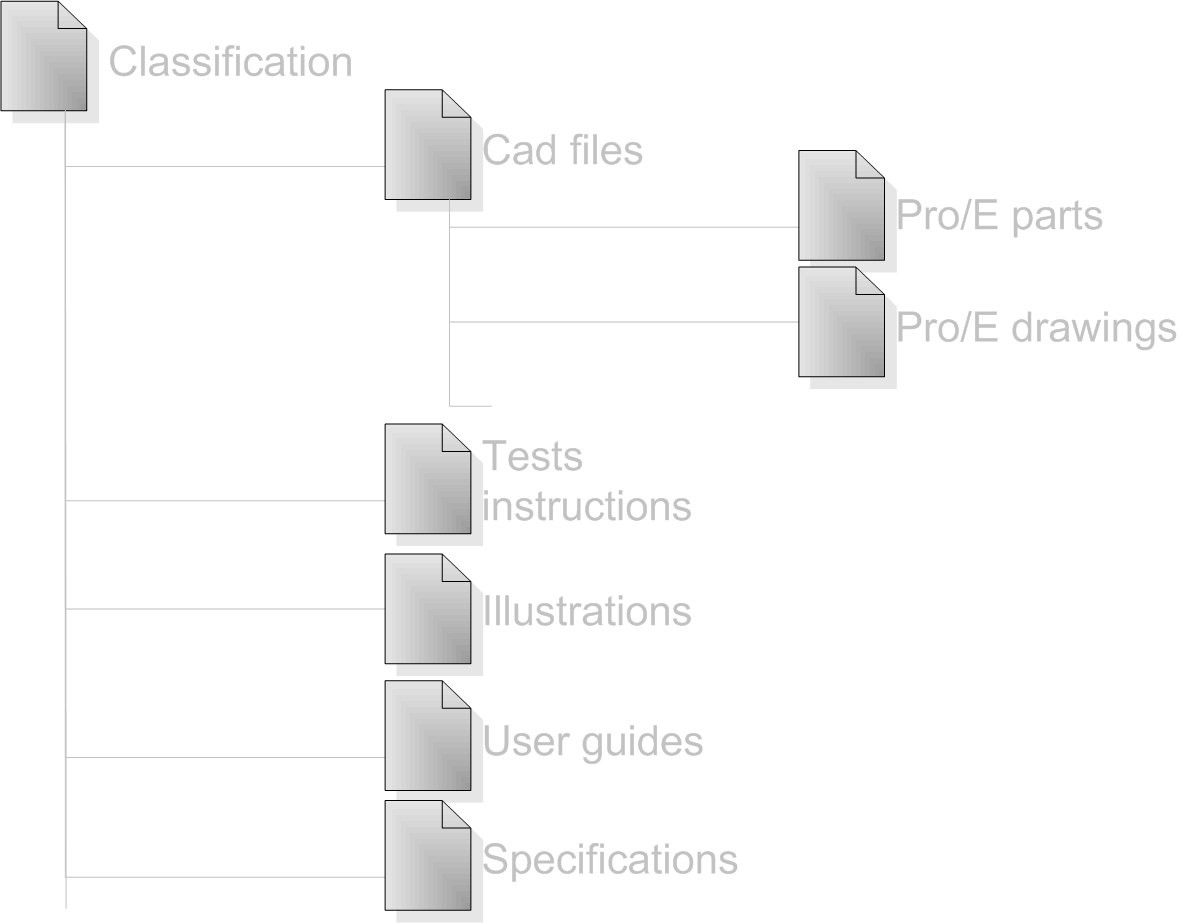 Figure 7: Classification is grouping of different kinds of documents with common attributes.
Figure 7: Classification is grouping of different kinds of documents with common attributes.Classification is the classification of similar or standard parts or documents, which are grouped by common attributes to support reuse and making it easier to search. An example with CAD files is depicted in fig. 7. Classification utilizes easy search functionalities by means of attribute values or ranges of values. These attributes may include material, release date, etc. When a new document is created some of the predefined links is determined by its classification.
Full text search
Further search capabilities within the PLM scope are available as full text search. Full text search works in the same way as Google on the documents in the document vault. The indexing of documents is often done every time the documents are checked into the system to prevent searching through all the documents every time a search is initiated.Project management
 Figure 8: Projects can be broken into sub projects and smaller tasks or activities, similar to the breakdown of products into smaller parts. Links between the activities and parts can be established.
Figure 8: Projects can be broken into sub projects and smaller tasks or activities, similar to the breakdown of products into smaller parts. Links between the activities and parts can be established.Project management can be used to model the stage/gate project models or other project models in a company. Projects can be divided into sub projects or tasks (work breakdown structures as illustrated in fig. 8), which can be structured with dependencies, milestones and resources and then used to e.g. find the critical path in a project as illustrated in fig. 9. Resource management can both be handled in the specific projects and across all projects, with internal and external workforce. Also for the project management the information related to projects are linked to the relevant pieces of information in the product structure. Requirement management, drawings or executables can be linked to the sub projects or tasks to track the project plan as well.
 Figure 9: Dependencies between the sub projects or tasks can be identified by links. The critical path in the project is marked with dark grey
Figure 9: Dependencies between the sub projects or tasks can be identified by links. The critical path in the project is marked with dark greyCollaboration tools
Collaboration tools are used to enable the cooperation in the extended enterprise. Communication across distances in a global world is a part of the PLM scope, and is improved with easy access to synchronous or asynchronous collaboration tools. Synchronous tools can be instant text messages, telephone calls or video conferences. Asynchronous tools can be text messages or mail.Collaboration is enabled, not only with new functionalities, but by providing the earlier mentioned processes and methods access to the web inside and outside the company's fire wall.
Functionalities to support virtual teams are also important in PLM systems because these functionalities are used to address some of the new challenges imposed by the introduction of global collaboration.
Visualization
Visualization is an important factor in collaboration. Collaboration is however often easier when the participants have the same foundation for the dialogue, such as a drawing or a 3D model. Access to viewers of 3D models is one of the ways to facilitate it. This functionality is further enhanced by providing remote desktop control, where two or more people with the ability to spin the model around and adding annotation directly to the model while the other participants can see the result of the actions in real time. The controller of the screen may grant a participant the ability to control the screen.
Redlining, where details of specific interests on a 2D or 3D model are marked within a red circle is another more simple way to mark changes in engineering change process.
Virtual product handling
The use of virtual product handling is a way to secure the exchange and access of the information online, which enables long distance collaboration within PLM. Virtual product handling is also a mean to cut loose of the slow material bound way. E.g. mock ups of prototypes or production preparation with simulation of product flows, which in many cases can be done quicker than the realization, and thereby shorten the time to market. However, the applications used to create the digital mockups and simulations etc. are not a part of the PLM IT system the information used and created by the systems are merely managed by the PLM IT system.
PLM processes
Best practice is combined with the business needs when the selected processes are improved by consultants from the specific PLM system supplier and employees at the company. And in the absence of disciplined methodology, this can be hard to accomplish in all the aspects. Implementing the PLM IT system itself, does not accomplish the benefits. The full effect of the benefits also requires work with the processes and continuous improvements of both.
PLM solution
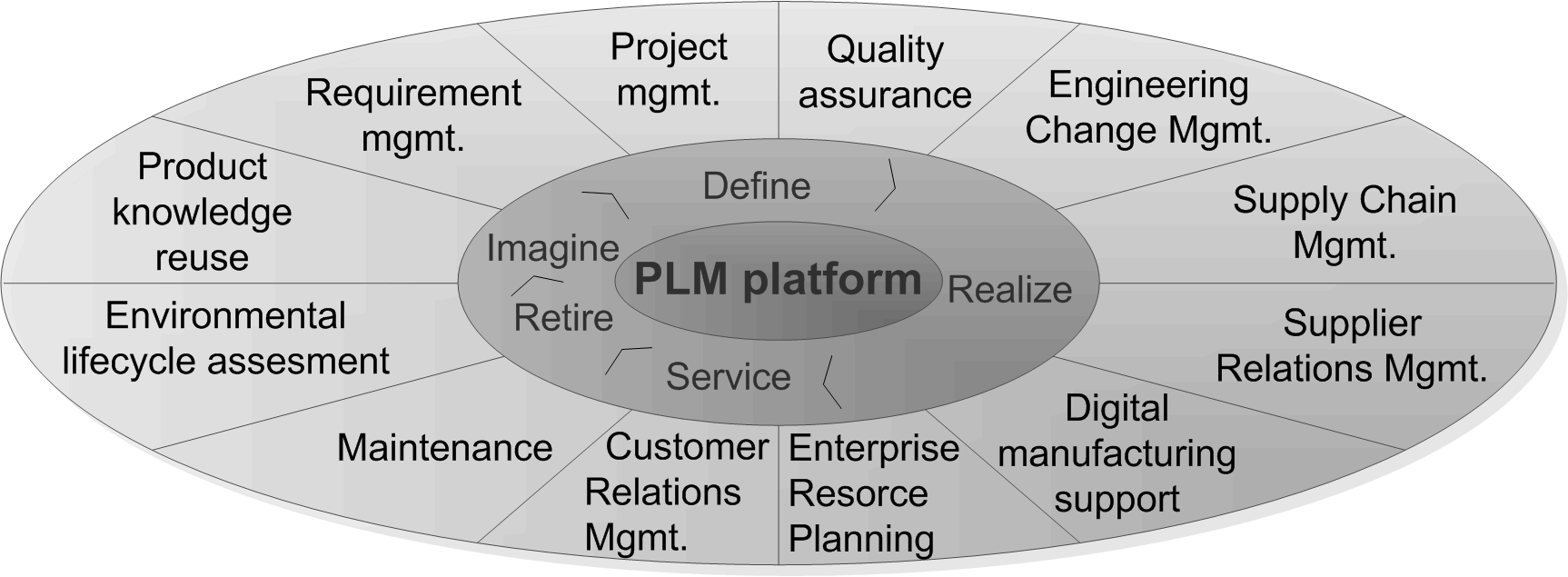 Figure 10: PLM relations and adjoining systems. PLM environment is a set of systems both IT systems and business processes, where PLM is the link between them with applying functions. E.g. exchange of BOM between PLM and ERP.
Figure 10: PLM relations and adjoining systems. PLM environment is a set of systems both IT systems and business processes, where PLM is the link between them with applying functions. E.g. exchange of BOM between PLM and ERP.The aforementioned functionalities associated with the PLM scope is not a new phenomena as such. Document and version control are already present in e.g. Microsoft Word or in Lotus Notes databases. PLM however, does not only provide these functionalities in the existing applications. PLM applies the functionalities across the extended enterprise, across the applications in PLM, and combines the IT functionalities with best practice in the processes. PLM provides these functionalities in a web based easy to access way, in which it is possible to combine the functionalities across each other. PLM makes it possible to break down the islands and create uniformly processes across different functions. As globalization and dispersed enterprises are increasing, PLM attend to relevant issues to enable business processes especially in relation to speed.
A PLM system is interfacing a lot of other enterprise systems (IT systems and other systems) to ensure the flow of information between them. PLM links between systems in the entire lifecycle.
As earlier mentioned a PLM solution is when information relating to the products flow across the enterprise, and people collaborate around it. In some of the workflows this can include manual processes. But to reach the benefits most of the flow must be semi- or full automatic.
Although PLM is not only an IT system, it is important that the PLM IT system is able to be connected with other IT systems in the enterprise, which are needed for the business processes in order to create an integrated enterprise. As PLM systems share information across the extended enterprise, the PLM system must be able to interface and to communicate to some extend with almost all of the IT systems in the company, ranging from enterprise class systems such the ERP systems, to small applications such as word processing. In fig. 10 some of the relations and adjoining systems of PLM and systems in a company are visualized. Examples of some of the specific exchanges of information and functionalities are mentioned in the following. An interface between PLM and the ERP system could be the exchange of the EBOM to the MBOM.
The connection between PLM and after sales service can be information concerning traceability for the retailers or downstream information from the market of the customers needs. It is important to notice that a PLM environment is a set of IT systems with integration to the PLM system, and that PLM does not replace for instance the ERP system, but that PLM for instance can replace the existing ECM system. The PLM systems tie the other systems together in a network providing systems, as well as people with the right information related to the product.
The greatest relation is typically between the PLM system and the ERP system. The ERP system handles most of the information in the realize phase where as the PLM system handles most of the information in the define and service phase, where the ERP system is lacking. However, the utilization of PLM within the realize phase is not used extensively in the businesses according to [Grieves, 2006].
The depth of connections between adjoining IT systems differ according to the specific needs and for the level of integration we use the terminology: encapsulation, interface and integration which are elaborated in the solution.
Knowledge management by means of PLM
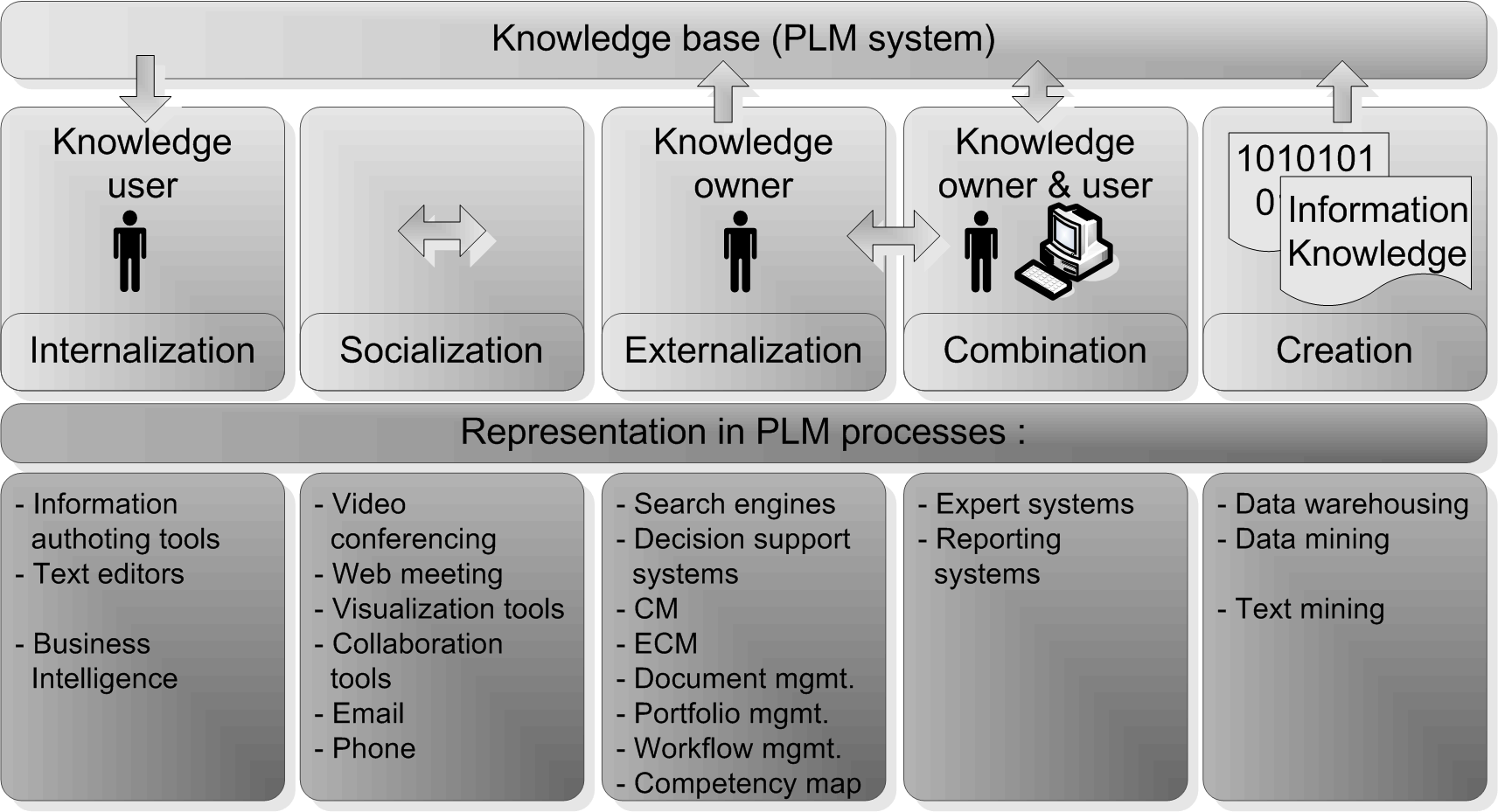 Figure 11: Transformation of knowledge in relation to the PLM system and the functionalities related to the PLM system. Figure based on [Ameri and Dutta, 2005].
Figure 11: Transformation of knowledge in relation to the PLM system and the functionalities related to the PLM system. Figure based on [Ameri and Dutta, 2005].As the society develops from an industrial society to a knowledge society, the collected amount of knowledge and the importance of knowledge, will increase. At the same time knowledge management will be more difficult in the future with an increased internationalization. In this section we will examine PLM in relation to knowledge management as opinions are divided on the matter.
We see knowledge management as sharing and use of knowledge in the business processes.
Knowledge sharing can be personalized or codified. The PLM system enables both kinds of knowledge sharing to a certain degree. Codified knowledge sharing via structured templates and personalized knowledge sharing via collaboration. We differentiate between four different ways of knowledge transformation based on sources [Ameri and Dutta, 2005] and [Nickols, 2000].
These transformations of knowledge are related to a PLM system in fig. 11.
o Externalization. When implicit knowledge is made explicit.
o Socialization. Sharing of tacit or implicit knowledge between individuals (could also benon written explicit knowledge)
o Internalization. Transforming explicit knowledge into tacit knowledge through learning.
o Combination. Combining two or more pieces of knowledge to generate new knowledge.
These transformations of knowledge are set in relation to different facilitating functionalities and IT modules within the scope of the PLM system, which directly or indirectly supports the transformations.
E.g. search engines indirectly help to internalize knowledge as it makes the knowledge easier to retrieve, and text editors directly help as it is the tool in which explicit knowledge is stored. The knowledge entering and leaving the PLM system in fig. 11 will be codified knowledge in documents. The socialization transformation can be personalized knowledge sharing, which can be enabled by the PLM system by collaboration tools or can just take place as a normal conversation.
As we see knowledge, it is spanned of three categories as seen in fig. 12. The explicit knowledge can, when it has been codified and committed to writing, be handled by the management and infrastructure for information in the PLM system (This is also why there is a thin line between explicit knowledge and information). Thus, information management is the first step to handle knowledge management formally.
 Figure 12: Three categories of knowledge as they are used in this report [Nickols, 2000] and [Polanyi, 1997]
Figure 12: Three categories of knowledge as they are used in this report [Nickols, 2000] and [Polanyi, 1997]The PLM systems also allows management of tacit and implicit knowledge, but this is more abstract, as described at the personalized knowledge sharing.
As we see the scope for PLM, knowledge management will be an increasing part of PLM, as the PLM industry controls information management and can focus on new challenges which are needed in a business perspective. So far, the capabilities are mostly PLM as knowledge repository, with explicit knowledge in documents in which the knowledge is more or less codified.
Knowledge management in each process has its own challenges and might require different approaches. Therefore, in a broad term, knowledge management in each lifecycle process is an independent research problem with its own contingencies and needs to be addressed individually, when the processes are treated in the PLM implementation.
PLM enabling innovation
The opinions are also divided with regard to whether PLM enables innovation or not. We believe that PLM is driving innovation by both minimizing the non innovative tasks and by enabling information and knowledge sharing across the extended enterprise. According to source [Romer, 1993] knowledge sharing and making people knowledgeable brings innovation and continued ability to create products and services.And that continuously innovation in product, process and organization is eased by means of a well integrated, suitable and correctly used PLM system, as the innovation-environment is created by collaboration and by using the knowledge and information in the company. According to source [Bilello, 2004] PLM can catch and manage the information and knowledge in the company, and thereby making it accessible for individuals, facilitating the innovation-environment.
PLM projects and adoptive change management
 Figure 13: Adoptive change management of the solution is important in the entire PLM project
Figure 13: Adoptive change management of the solution is important in the entire PLM project As this article describes PLM involves extensive changes which apply to a great part of the employees. Furthermore the implementation of PLM is often a very long haul which can last for years. This makes adoptive change management an important part of a successful PLM project and it must be a proactive element in the entire project from the creation of the PLM vision to the PLM system in daily operation as it is pictured in fig. 13.
It must be considered which people must be involved at which times, and as resistance towards change is the natural reaction, this must be handled.
As described in this article the work with improving processes and integrating the processes in the IT system, developing the classifications etc. is an important part of the implementation and requires an effort. The work done with the PLM system determines, whether it is a great help or a great expense. This makes the adoptive change management crucial for the PLM system.
Summary
The PLM IT system is a set of complex and well integrated functionalities which capture, manage and disperse documents and information in the extended enterprise in the entire lifecycle.
Moreover the functionalities enables worldwide collaboration integrated around this information management
Literature
P. Bilello. Plm: Enabling innovation. http://www.cioupdate.com/trends/article.php/3403211, 2004.
CIMdata. collaborative product definition management (cpdm) an overview. http://www.cimdata.com/publications/cPDm_Def.pdf, 2001.
CIMdata. Pdm to plm - growth of an industry. http://cimdata.com/publications/, 2003a.
CIMdata. Product lifecycle management -empowering the future of business. http://cimdata.com/publications/PLM_Definition_0210.pdf, 2003b.
CIMdata, J. MacKrell, P. Billelo, and G. Litjens. Interviews and conversations with cimdatas consultants relating to plm. Interviews, 2005.
I. Crnkovic and U. Asklund. Product Data Management & Software Configuration Management. Artech House, 2003. ISBN 1580534988.
M. Grieves. Product Lifecycle Management- driving the next generation of lean thinking. McGraw-Hill, 2006. ISBN. 0-07-145230-3.
IBM. Interviews and conversations with ibm relating to plm (michael kraus). Interviews, 2006.
F. Nickols. The knowledge in knowledge management (km). http://home.att.net/ nickols/Knowledge_in_KM.htm, 2000.
M. Polanyi. Knowledge in Organizations. Butterworth-Heinemann: Boston, laurence prusak, editor edition, 1997. Chapter 7.
P. Romer. Idea gaps and object gaps in economic development. Journal of Monetary Economics, Vol. 32, 1993.
J. Stark. Product Lifecycle Management. Springer Verlag London Limitted, 1th edition, 2005. ISBN. 1852338105.